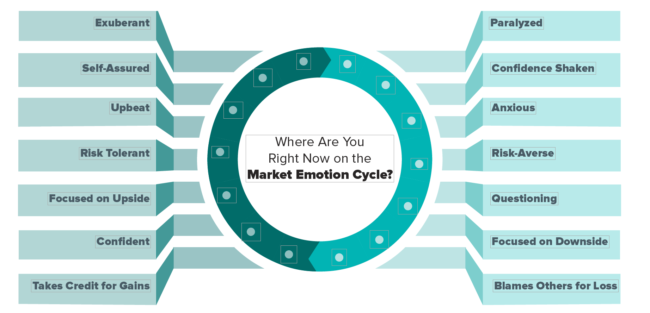
Are You Ready for the Rebound?
Do you feel like you’re caught in an emotional spin cycle, tossed this way and that by the market fluctuations and not sure what to do? Don’t feel alone. Many of us are victims of the emotional cycle of investing. Here are some tips to get ready for the rebound.
Strategies to Break The Emotional Cycle of Investing
As uncertainty surrounding the economic impact of the coronavirus has accelerated, the markets have taken a toll on investor portfolios and confidence. The swift end to what was the longest-running bull market in history has led many to wonder when a lasting rebound might begin.
While we can’t know with any certainty when the turn will come, what we do know is that history is on the investor’s side. Since the end of World War II, the average annualized return of the U.S. stock market has been 11.28%.1 Investing in a diversified mix of stocks and bonds remains one of the best options to help outpace inflation, accumulate long-term wealth and achieve your financial goals. The question is not where the market is going, but where are you going? Are your investments positioned properly for the rebound? What lessons have you learned from the correction, and what should you do now?
You can start by understanding how emotions affect your behavior in turbulent times. Irrational investor behavior in up and down markets will impact your portfolio’s return. Caught in an emotional cycle, investors feel confident and exuberant in bull markets,
and many take more risk than they should. Then, when the bear returns, they lose that confidence and often overreact in the opposite direction. Right now, many investors are frozen or sitting on the sidelines, not sure of their next move.

1 Annualized total return of S&P 500 Index from Jan. 1, 1945 to Dec. 31, 2019, Source: NYU Stern School of Business
The launch date of the S&P 500 Index was March 4, 1957. Information for an index prior to its launch date is back-tested, based on the methodology that was in effect on the launch date. Back-tested performance, which is hypothetical and not actual performance, is subject to inherent limitations because it reflects application of an index methodology and selection of index constituents in hindsight. No theoretical approach can take into account all the factors in the markets in general and the impact of decisions that might have been made during the actual operation of an index. Actual returns may differ from, and be lower than, back-tested returns.
Don’t Fall Into the Trap of Buying High and Selling Low
In the 2008 bear market, brought on by the Great Recession, skittish investors sold their investments or moved to cash in disturbing numbers. Confidence was shaken by steep declines, and investors grew anxious, with many abandoning well-thought-out strategies. Even though stock prices were at record lows, many investors focused on the downside and looked for someone to blame.
We saw almost the opposite happen toward the end of the bull market that began at the lows of the Great Recession and lasted until March 2020. Investors poured money into mega-cap technology stocks at increasing valuations. Fueled by the growth in these companies, individuals remained upbeat and confident in their supposed investment acumen; they focused on the upside, ignoring risks and inflated prices.
In both cases, many investors behaved irrationally, buying high and selling low. The point is, it’s difficult to time the market. We can see proof in the “Guess Right Ratio,” published by the investment research firm DALBAR. The ratio measures how often the average equity investor makes a good timing decision. When you compare index returns with actual returns for the average investor, it’s clear many tend to literally sell themselves short. For example, the S&P 500 Index returned a respectful 6.1% annually for the 20 years ending Dec. 31, 2019. But because the average investor sold and missed several good market days, they earned only 4.3%, a difference of over 40% in cumulative returns over the 20-year period.2
Getting the picture? Timing is difficult, and impatience erodes return. Picking a strategy for each of your goals and sticking with it—assuming your individual circumstances haven’t changed—is often the most viable solution. But as we’ve shown, many investors find it difficult. So what should you do now, particularly if you have been sitting on the sidelines with money to invest? Here are some positive steps you can take, remembering that doing nothing is likely not a good option.
Manage Your Behavior
When it comes to behavior, too much knowledge is a good thing. When markets move through their cycles, investors should avoid getting caught in the emotional highs and lows. The best course for most long-term investors is to change their strategy only when their personal circumstances change, not when the market changes. So don’t try to time the market. Pick a long-term strategy and stick with it.
Reevaluate Goals
Staying focused on your goals can serve you well in tough markets. To ensure your strategy is appropriate, now is the time to reevaluate goals and reassess risk tolerance and time horizon. There’s evidence to show that investors who are focused on goals–as opposed to returns–are more likely to stick with a strategy and not head for the sidelines during market corrections.
Take Advantage of Dollar-cost Averaging
A simple way to systematically ease back into the market is dollar-cost averaging–a good option to help avoid buying high and selling low. Simply put, it involves contributing the same dollar amount to an investment irrespective of price. Let’s say you’re contributing $500 per month to a mutual fund in your IRA, which is priced at $10 per share. With each contribution, you’re purchasing 50 shares.
If the price drops to $9, your contribution will buy approximately 55.5 shares. If it goes to $11, you’ll buy about 45.5 shares. You’re buying more shares when the price drops and fewer when it rises. Over time, consistent contributions–as opposed to stopping and starting–can help lower your overall investment costs.
Face the Facts. Look Inward.
As you evaluate your situation, keep two things in mind. First, volatility is a fact of life. Successful investors can ride out the dips in the road no matter how steep. Second, history has shown that a diversified investment portfolio of fixed-income and equity investments can help increase the likelihood you’ll outperform inflation, an investor’s biggest nemesis.
Finally, rather than looking outward at the market, look inward. What are your goals, what levels of risk can you really live with during difficult time periods, and what steps can you take now to ensure you are ready for the rebound?
As financial advisors, we are committed to:
- Better understanding your needs and goals.
- Helping you avoid emotionally driven mistakes.
- Helping you better understand the markets.
- Providing options and explaining the trade-offs of each.
- Being available to consult with you in all markets.
If you’re considering working with us here at Mosaic, we invite you to learn more about who we serve and how we help them. You can also contact us with any questions you have.
Past performance does not guarantee future results. There are risks involved with investing, including possible loss of principal. Bonds will decrease in value as interest rates rise. Diversification may not protect against market risk. Index returns are for illustrative purposes only and do not represent actual portfolio performance. Index returns do not reflect any management fees, transaction costs or expenses. One cannot invest directly in an index. Past performance does not guarantee future results.
The S&P 500 Index or the Standard & Poor’s 500 Index is a market-capitalization-weighted index of the 500 largest U.S. publicly traded companies. The S&P is a float-weighted index, meaning company market capitalizations are adjusted by the number of shares available for public trading. Information provided by SEI Investments Management Corporation (SIMC), a wholly owned subsidiary of SEI Investments Company (SEI). This material is not intended to be a forecast of future events or a guarantee of future results. This information should not be relied upon by the reader as research or investment advice and is for educational purposes only. There can be no assurance your goals will be met. Your advisor is not affiliated with SEI or any of its subsidiaries, but may work with SEI to provide some of the services listed in this piece.
This is an article published by SEI in the Knowledge Center.
If you’re considering working with us here at Mosaic, we invite you to learn more about who we serve and how we help them. You can also contact us with any questions you have.
Securities and advisory services offered through Cetera Advisors LLC, Member FINRA/SIPC, a broker/dealer and a Registered Investment Advisor. Cetera is under separate ownership from any other named entity.







